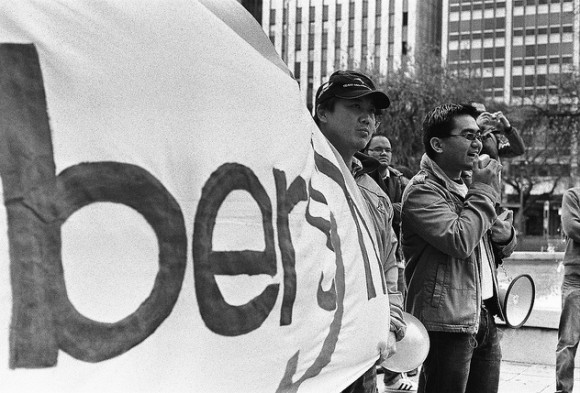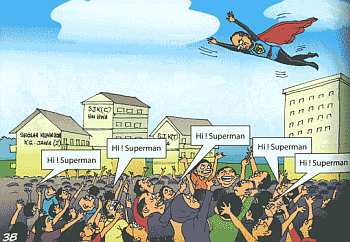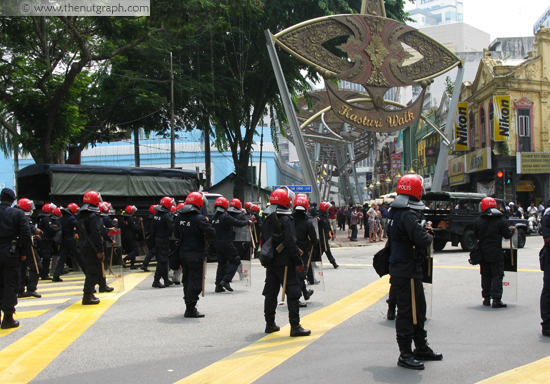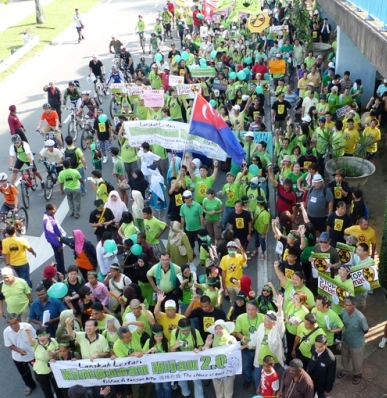By Ding Jo-Ann | 28 April 2012 |
THIS afternoon, the Coalition for Clean and Fair Elections (Bersih 2.0) will hold its third major demonstration in the city. On 9 July last year, up to 50,000 protesters took to the streets to demand for clean and fair elections despite heavy-handed government tactics to clamp down on the civil society-led movement.

Supporters during the Bersih 2.0 rally on 9 July 2011. (Pic by Jeremy Choo @ Flickr)
Although the government denounced Bersih 2.0 as a dangerous, illegal entity, it eventually set up a parliamentary select committee (PSC) on electoral reform, which tabled its report to Parliament on 3 April 2012.
But Bersih 2.0 remains dissatisfied. Even before the report was tabled, it announced it would hold a sit-in at Dataran Merdeka, dubbing it Bersih 3.0. Why isn’t the movement satisfied and what, really, is its purpose? The Nut Graph asks Bersih 2.0 steering committee member and political scientist Wong Chin Huat to explain.
Bersih 2.0 announced its demonstration even before the Election Commission(EC) had met and discussed the PSC’s recommendations. Is Bersih 2.0 being impatient by not giving the EC a fair chance? And isn’t the setting up of a PSC already a step in the right direction?
The case for Bersih’s sit-in was based on two facts. First, the PSC cannot guarantee thorough electoral reforms before the next general election. Second, more electoral fraud and irregularities continue to emerge during and after the PSC’s operation.
From the PSC report, it is clear some of Bersih’s key demands will not be fulfilled. Crucially, the report was silent on corruption and dirty politics. It did call for long-term EC reform and the setting up of a caretaker government. But there were no concrete measures suggested to penalise and deter abuse of government machinery.
In fact, immediately after the release of the report, cartoons showing (Prime Minister Datuk Seri) Najib (Razak) as Superman were distributed in schools, and Barisan Nasional (BN) flags were hung in KTM stations in Selangor. If this is how things are now, how much worse will it get when elections are called?

(Courtesy of The Malaysian Insider)
Most shockingly, voters with the same names and birthdays but slightly different identity card (IC) numbers were found. This suggests cloning or “multiplication” of voters, to allow multiple voting or impersonation
The PSC report did not address this. It did not propose abolition of Section 9A of the Elections Act, which prevents electoral rolls from being challenged in court. How can you expect the electoral roll to be cleaned up when the system’s structural flaws remain? Civil society has submitted detailed proposed amendments to election laws, but the report refused to affirm the right of all overseas Malaysians to vote as absent voters.
The crux is, notwithstanding some good suggestions, the PSC’s recommendations will not ensure a clean 13th general election. Deciding not to waste time talking to the EC is therefore not denying the EC a fair chance. Rather it is about giving Malaysian citizens a fair chance at clean and fair elections so that voters can decide who runs this country when the next general election is called.
How would you respond to allegations that Bersih 3.0 is merely a political ploy of the opposition to garner support before the next general election?
Bersih 2.0 has always adopted a nonpartisan and multipartisan approach, namely that we will work with any party to pursue electoral reforms. If only the opposition parties demand clean elections, we should not question why they support the cause. Instead we should ask, where are the BN parties? Why doesn’t the BN want clean elections? Why doesn’t the BN garner support by implementing electoral reforms?
The EC has said some of the electoral roll’s discrepancies, including the existence of a 149-year-old voter, are because of mistakes in people’s ICs, which is not under their purview. It also said political parties themselves have been responsible for mistakes when they submit voter registration forms. Is it fair to blame everything on the EC?
I would never rule out genuine clerical errors, whether caused by assistant registrars or EC staff. However, the problems with the rolls don’t seem to go away. When complaints are made about fraudulent electoral records, those may be cleaned up but errors turn up again in new guises. We cannot eliminate the problems because new ones are being manufactured daily.
Unless the EC is willing to be transparent and expose those officials involved in these erroneous records, it cannot accuse others of blaming everything on it. The Federal Constitution requires EC members to enjoy public confidence. Can we have confidence with the current team when they make dead people alive and living people dead?
How has the government responded to talk of a rally this time? Have they been more responsive to Bersih 2.0′s aims?
Prime Minister Najib has been unusually quiet on Bersih 3.0. He suffered a severe drop in popularity after the Bersih 2.0 crackdown where six were detained without trial under theEmergency Ordinance and a record 1,667 persons arrested on the same day.

Heavy police presence in downtown Kuala Lumpur on the morning of 9 July 2011.
This time, Najib has chosen to use media blackout instead of police violence to contain the soaring support for Bersih 3.0 from all sectors. However, old habits die hard. This week, Dewan Bandaraya Kuala Lumpur (DBKL) and the police rejected our sit-in plan at Dataran Merdeka. DBKL even acted like the police in removing protesters at Dataran Merdeka last week, and a day before the sit-in declared that Bersih 3.0 had become a “security issue”. Home Minister Datuk Seri Hishammuddin Hussein has also threatened that police will take the necessary action against demonstrators if they turn up at Dataran Merdeka.
Will DBKL, an unelected entity and an extension of the federal government, employ violence to forcibly remove Bersih 3.0 protesters? Will the police act in the same way they did last year? It depends. The larger the crowd, the safer everyone will be! DBKL or the police will find it difficult to accommodate 50,000 protesters in the lock-up.
If Bersih 3.0 doesn’t have the same turnout as Bersih 2.0, does that mean that previously disenchanted voters are now satisfied with the government’s measures to address complaints about the electoral system? Would it mean that Bersih 2.0′s cause no longer has the same level of public support as before?
Barring police and DBKL obstacles, if our numbers are smaller than or equals last year’s turnout, then Najib can say the public has bought his “reforms” and the EC can boast that the Malaysian electoral rolls are the cleanest on earth.
However, I doubt that is possible. I haven’t come across a single person who went to the Bersih 2.0 rally who has decided not to join Bersih 3.0. Conversely, I have met countless people who missed Bersih 2.0 and vow not to miss Bersih 3.0. Rain or shine, roadblocks or not, they will get as close as possible to Dataran Merdeka.
We have two simple directions to all participants. First, the sit-in starts the moment they get blocked from moving forward. Second, once the police start arresting peaceful protesters, others should turn themselves in. Last year, the police prepared nasi briyani for 1,667 persons. Let’s see if they have ordered enough for 5,000 or 10,000 people this time.
We are prepared to engage in civil disobedience to defy unjust authority. We will not be broken by the force of violence. Instead, DBKL and the police must be prepared to have their authority broken by brave Malaysians who will walk and sit in until they get arrested.
What will be the effect of other causes such as Occupy Dataran, Abolish PTPTNand Himpunan Hijau also converging on Bersih 3.0? Do you think the message of Bersih 3.0 will be diluted?
Not at all. The anti-Lynas group is there as Himpunan Hijau 3.0@Bersih 3.0. We have mothers who believe their children’s future is at stake if politicians are protected by dirty elections. They call themselves Mamas@Bersih 3.0. So, any group can be there as part of the national force demanding clean elections. If you have a specific cause to champion, come to Dataran Merdeka on 28 April as “Your Cause@Bersih 3.0″.

Himpunan Hijau 2.0 rally in February 2012. All are welcome to join the Bersih 3.0 gathering. (Pic by Gan Pei Ling)
Why is Bersih insisting on gathering at Dataran Merdeka? Why not one of the other venues suggested by DBKL?
Dataran Merdeka is historical and easy to access by public transport. No stadium can beat Dataran Merdeka on this. Getting us to move to Cheras or Titiwangsa would be irresponsible by creating traffic jams in nearby residential areas. How many taxis do you need to ferry 100,000 protesters or more? How many hours of traffic jams can you bring to those areas?
In comparison, as long as the police and DBKL do not put up roadblocks, and coach operators are not stopped from entering the city, traffic will not be much greater than on a normal busy Saturday. And we will bring in millions of ringgit of business to downtown Kuala Lumpur. I hereby urge Najib, the ultimate boss of DBKL and the police, not to sabotage the economy of downtown Kuala Lumpur.
As for Stadium Merdeka, which is in the heart of Kuala Lumpur, how do you do a sit-in in a closed stadium? What happens after the field is full? Do we ask people to sit on the seats? How do people move around with limited entry and exit points?
In contrast, Dataran Merdeka is perfect for a sit-in. People can come and go easily from its four open borders. If the crowd is too big, they can spill over to open spaces nearby like Taman Tasik. Why are they trying to stop us from using Dataran Merdeka, which is logistically superior? Is there a problem with the word “Merdeka” as with “Bersih”? 
No comments:
Post a Comment